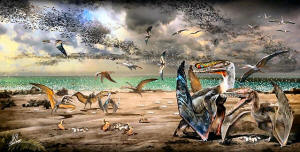|
Dazzling egg fossils crack open secrets
of ancient flying reptiles
 Send a link to a friend
Send a link to a friend
 [December 01, 2017]
By Will Dunham [December 01, 2017]
By Will Dunham
WASHINGTON (Reuters) - A dazzling discovery
in northwestern China of hundreds of fossilized pterosaur eggs is
providing fresh understanding of these flying reptiles that lived
alongside the dinosaurs including evidence that their babies were born
flightless and needed parental care.
Scientists said on Thursday they unearthed 215 eggs of the fish-eating
Hamipterus tianshanensis -- a species whose adults had a crest atop an
elongated skull, pointy teeth and a wingspan of more than 11 feet (3.5
meters) -- including 16 eggs containing partial embryonic remains.
Fossils of hundreds of male and female adult Hamipterus individuals were
found alongside juveniles and eggs at the Xinjiang Uygur Autonomous
Region site, making this Cretaceous Period species that lived 120
million years ago perhaps the best understood of all pterosaurs.

"We want to call this region 'Pterosaur Eden,'" said paleontologist
Shunxing Jiang of the Chinese Academy of Sciences' Institute of
Vertebrate Paleontology and Paleoanthropology.
Pterosaurs were Earth's first flying vertebrates. Birds and bats
appeared later.
Until now, no pterosaur eggs had been found with embryos preserved in
three dimensions. Researchers think up to 300 eggs may be present, some
buried under the exposed fossils.
The embryonic bones indicated the hind legs of a baby Hamipterus
developed more rapidly than crucial wing elements like the humerus bone,
said paleontologist Alexander Kellner of Museu Nacional in Rio de
Janeiro.
"Some birds can fly on the same day they break out from the egg, while
some others will need a long period of parental care. Our conclusion is
that a baby Hamipterus can walk but can't fly," Jiang said, an
unexpected finding.
[to top of second column] |

An artistís illustration shows individuals from the fish-eating
pterosaur species Hamipterus tianshanensis, including adults,
juvenile and eggs in this handout illustration obtained by Reuters
November 30, 2017. Fossils of hundreds of Hamipterus individuals and
more than 200 eggs were discovered at a site in Xinjiang Uygur
Autonomous Region in northwestern China. Zhao Chuang/Handout via
REUTERS

The researchers believe these pterosaurs lived in a bustling colony
near a large freshwater lake. Kellner cited evidence that females
gathered together to lay eggs in nesting colonies and returned over
the years to the same nesting site.
They suspect the eggs and some juvenile and adult individuals were
washed away from a nesting site in a storm and into the lake, where
they were preserved and later fossilized.
The oblong eggs, up to about 3 inches (7.2 cm) long, were pliable
with a thin, hard outer layer marked by cracking and crazing
covering a thick membrane inner layer, resembling soft eggs of some
modern snakes and lizards.
There had been a paucity of pterosaur eggs and embryos in the
paleontological record because it is difficult for soft-shelled eggs
to fossilize.
The research was published in the journal Science.
(Reporting by Will DunhamEditing by Sandra Maler)
[© 2017 Thomson Reuters. All rights
reserved.]
Copyright 2017 Reuters. All rights reserved. This material may not be published,
broadcast, rewritten or redistributed.

 |